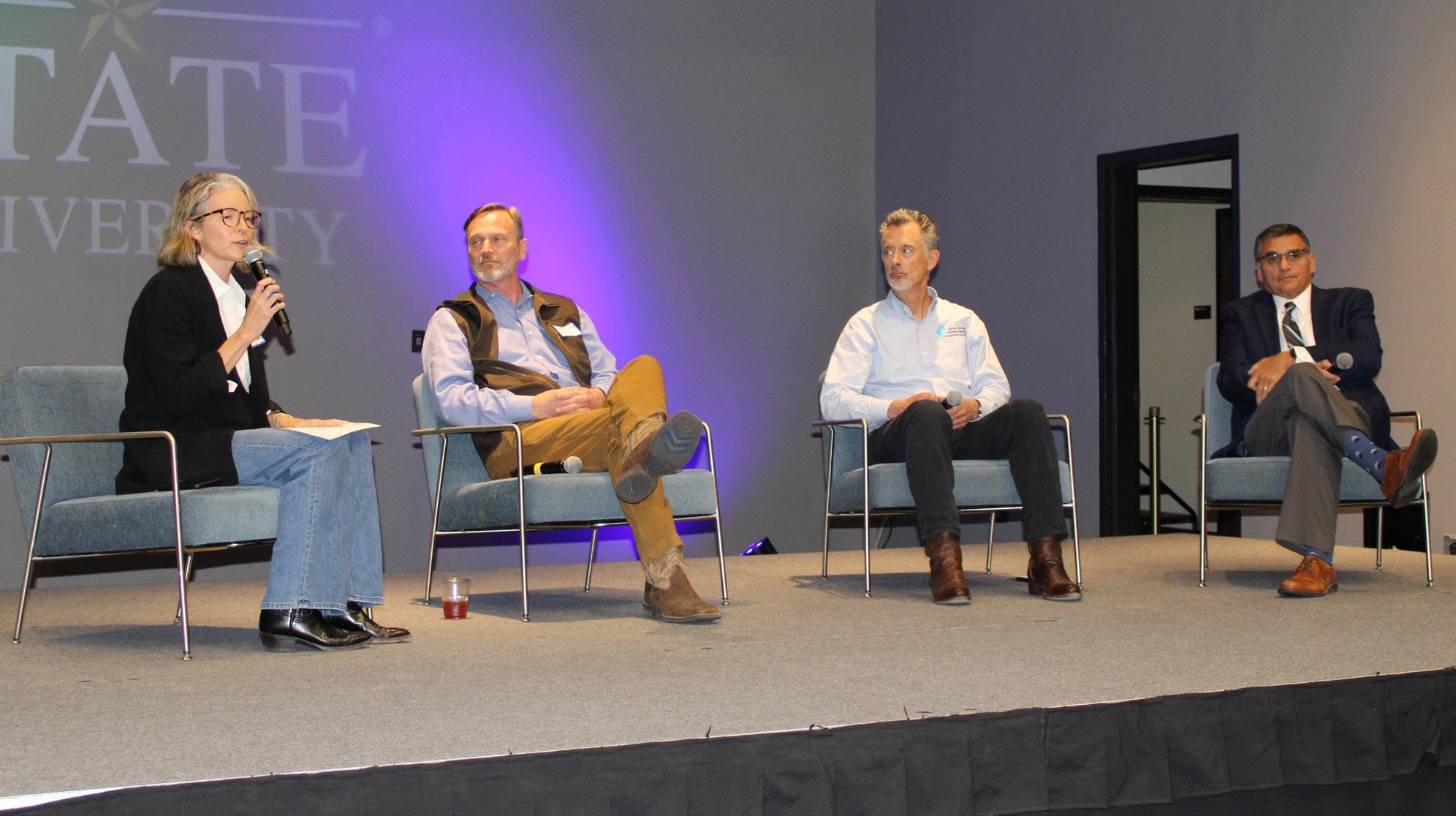Experts talk water, or lack thereof, in aquifers
Experts talk water, or lack thereof, in aquifers San Marcos Daily Record


Groundwater Symposium Highlights the Importance of Aquifer Conservation

This is the first of a two part series on the Groundwater Symposium that occurred at Texas State University on April 2 bringing together the area’s groundwater conservation district leaders.
Introduction
With the current drought and the level of eco-anxiety amongst the public at an all time high, groundwater, particularly the protection of local aquifers, is a hot topic of conversation. Texas State University’s Office of Sustainability and Department of Geography and Environmental Studies, along with the Barton Springs/Edwards Aquifer Conservation District, hosted a Groundwater Symposium on April 2 at the LBJ Student Center to discuss hydrogeology, management and conservation of local aquifers.
Panel Discussion on Aquifer Management
During the event, a panel was moderated by Texas Water Program Director Vanessa Puig-Williams and was composed of Hays Trinity Groundwater Conservation District General Manager Charlie Flatten, Barton Springs/Edwards Aquifer Conservation District General Manager Tim Loftus and Edwards Aquifer Authority General Manager Roland Ruiz.
The Importance of Managing the Edwards Aquifer
Ruiz explained that the Edwards Aquifer Authority (EAA) was established due to concerns about managing the interconnected system that provides groundwater to south central Texas. The challenge lies in the fact that groundwater is treated differently under the law than surface water in Texas. The EAA was created to ensure continuous minimum spring flows in all spring systems and to prevent federal intervention due to the presence of protected native species.
Regulatory Framework and Permitting
The EAA implemented a management scheme that includes a “hard cap” on the amount of water that can be extracted from the aquifer each year. Permits are issued according to a defined system, and the total number of permits has reached its limit. Those without permits or wells must purchase them from existing permit holders, which has led to the monetization of water and increased the need for conservation efforts.
Role of Barton Springs/Edwards Aquifer Conservation District
The Barton Springs/Edwards Aquifer Conservation District (BSEACD) initially focused on Barton Springs and later expanded its regulatory scope to include the Edwards Aquifer. The BSEACD has developed a nuanced permitting process to protect spring flows and endangered species. Additionally, the BSEACD collaborates with other groundwater districts, such as the Hays Trinity Groundwater Conservation District (HTGCD), to establish groundwater management zones and enforce rules for conservation.
Hays Trinity Groundwater Conservation District’s Approach
The HTGCD, although having fewer regulatory tools, has implemented a robust groundwater monitoring system with 85 wells contributing data. The district focuses on grassroots work and community engagement to promote conservation. It has also established a groundwater management zone, such as the Jacob’s Well Groundwater Management Zone, to protect groundwater resources in specific geographic areas.
Challenges and Future Directions
The panelists acknowledged the complexity of managing different aquifers and the need for further scientific understanding. The BSEACD is actively involved in research projects to enhance their understanding of the Trinity Aquifer. As knowledge evolves, there will be an increase in protections for these valuable resources.
SDGs, Targets, and Indicators
1. Which SDGs are addressed or connected to the issues highlighted in the article?
- SDG 6: Clean Water and Sanitation
- SDG 15: Life on Land
2. What specific targets under those SDGs can be identified based on the article’s content?
- SDG 6.5: By 2030, implement integrated water resources management at all levels, including through transboundary cooperation as appropriate.
- SDG 15.1: By 2020, ensure the conservation, restoration and sustainable use of terrestrial and inland freshwater ecosystems and their services, in particular forests, wetlands, mountains and drylands, in line with obligations under international agreements.
3. Are there any indicators mentioned or implied in the article that can be used to measure progress towards the identified targets?
Yes, the following indicators can be used to measure progress towards the identified targets:
- Indicator 6.5.2: Proportion of transboundary basin area with an operational arrangement for water cooperation.
- Indicator 15.1.1: Forest area as a proportion of total land area.
Table: SDGs, Targets, and Indicators
| SDGs | Targets | Indicators |
|---|---|---|
| SDG 6: Clean Water and Sanitation | Target 6.5: By 2030, implement integrated water resources management at all levels, including through transboundary cooperation as appropriate. | Indicator 6.5.2: Proportion of transboundary basin area with an operational arrangement for water cooperation. |
| SDG 15: Life on Land | Target 15.1: By 2020, ensure the conservation, restoration and sustainable use of terrestrial and inland freshwater ecosystems and their services, in particular forests, wetlands, mountains and drylands, in line with obligations under international agreements. | Indicator 15.1.1: Forest area as a proportion of total land area. |
Sources:
Behold! This splendid article springs forth from the wellspring of knowledge, shaped by a wondrous proprietary AI technology that delved into a vast ocean of data, illuminating the path towards the Sustainable Development Goals. Remember that all rights are reserved by SDG Investors LLC, empowering us to champion progress together.
Source: sanmarcosrecord.com

Join us, as fellow seekers of change, on a transformative journey at https://sdgtalks.ai/welcome, where you can become a member and actively contribute to shaping a brighter future.







